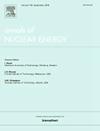Numerical Investigation on molten Lead–Bismuth Eutectic solidification characteristics outside vertical tube bundles
IF 1.9
3区 工程技术
Q1 NUCLEAR SCIENCE & TECHNOLOGY
引用次数: 0
Abstract
The molten Lead–Bismuth Eutectic (LBE) solidification is a critical safety issue in the operation of lead-cooled fast reactors. Under overcooling conditions, the LBE located in the heat exchanger is prone to solidification. However, there are currently no studies on the LBE solidification outside the vertical tube bundles. In this paper, a three-dimensional CFD model of LBE solidification outside the vertical heat exchange tube bundles will be established by using ANSYS FLUENT software. The transient solidification process was analyzed by examining the key parameters including the transient temperature field, solidification fraction and the first blockage location. The effects of the subcooling temperature, Reynolds number and mushy zone parameters on the solidification process were revealed. The findings play an important role in strengthening the understanding of complex solidification behavior in lead-cooled fast reactor.
求助全文
约1分钟内获得全文
求助全文
来源期刊

Annals of Nuclear Energy
工程技术-核科学技术
CiteScore
4.30
自引率
21.10%
发文量
632
审稿时长
7.3 months
期刊介绍:
Annals of Nuclear Energy provides an international medium for the communication of original research, ideas and developments in all areas of the field of nuclear energy science and technology. Its scope embraces nuclear fuel reserves, fuel cycles and cost, materials, processing, system and component technology (fission only), design and optimization, direct conversion of nuclear energy sources, environmental control, reactor physics, heat transfer and fluid dynamics, structural analysis, fuel management, future developments, nuclear fuel and safety, nuclear aerosol, neutron physics, computer technology (both software and hardware), risk assessment, radioactive waste disposal and reactor thermal hydraulics. Papers submitted to Annals need to demonstrate a clear link to nuclear power generation/nuclear engineering. Papers which deal with pure nuclear physics, pure health physics, imaging, or attenuation and shielding properties of concretes and various geological materials are not within the scope of the journal. Also, papers that deal with policy or economics are not within the scope of the journal.
 求助内容:
求助内容: 应助结果提醒方式:
应助结果提醒方式:


